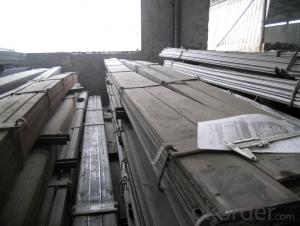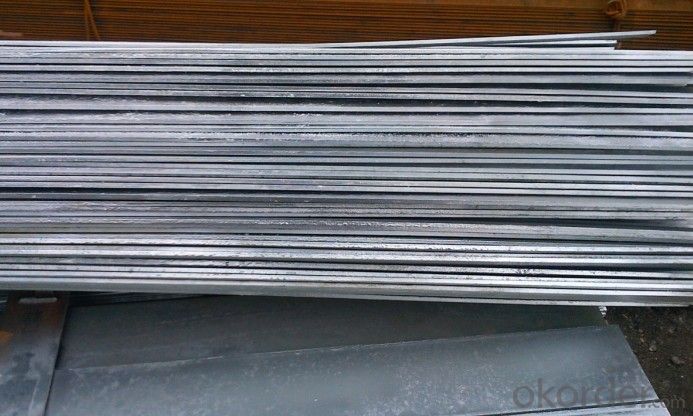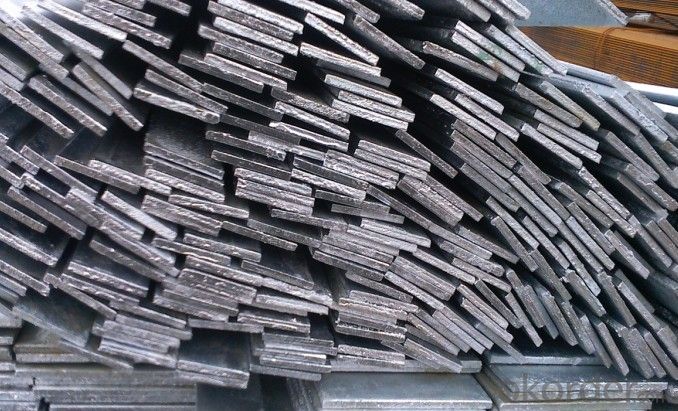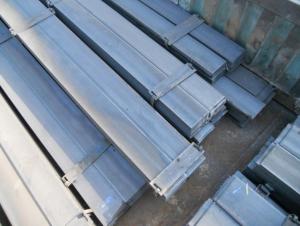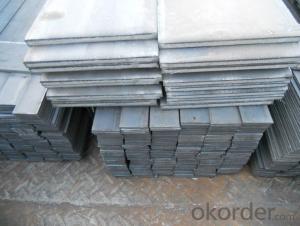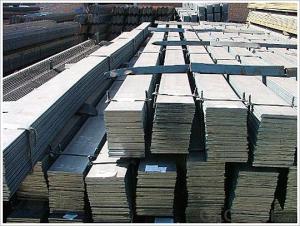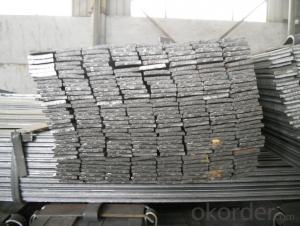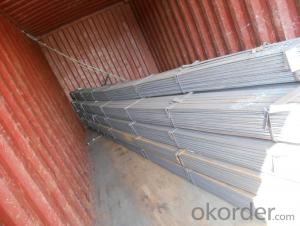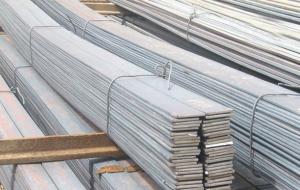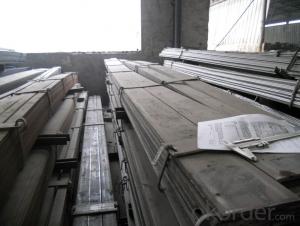high quality low carbon JIS steel flat bar
- Loading Port:
- Tianjin
- Payment Terms:
- TT OR LC
- Min Order Qty:
- 5 m.t.
- Supply Capability:
- 1000 m.t./month
OKorder Service Pledge
OKorder Financial Service
You Might Also Like
Product Description:
Specification of Mild Steel Flat Bar
Commodity: Mild Steel Flat Bar
Standard: GB;JIS
Material: Q195-235;SS400
Brand name: FLATSPACE
Origin place: China
Thickness: 3mm-30mm
Width:20mm-200mm
Length: Max 12m
Certification: SGS/BV
Chemical composition of Q235
Alloy No | Grade | Element(%) | ||||
C
| Mn
| S
| P
| Si
| ||
Q235
|
B
|
0.12—0.20 |
0.3—0.7 |
≤0.045 |
≤0.045
|
≤0.3
|
Physical properties of Q235
Alloy No | Grade | Yielding strength point(Mpa) | Tensile strength (Mpa) | Elongation after fracture(%) | ||||||
Thickness (mm) | Thickness (mm) | |||||||||
≤16 | >16--40 | >40--60 | >60--100 | ≤16 | >16--40 | >40--60 | >60--100 | |||
≥ | ≥ | |||||||||
Q235 |
B |
235 |
225 |
215 |
205 |
375--500 |
26 |
25 |
24 |
23 |
Usage/Applications of Mild Steel Flat Bar
Widely used for construction, Machinery manufacturing, Iron tower steel structure, Shipbuilding; Steel grating, Staircase, Bridge, Viaduct, Railway spare parts, Boilers making etc.
Packaging & Delivery of Mild Steel Flat Bar
Packaging Details: The Mild Steel Flat Bars are packed in bundles and loaded in 20 feet/40 feet container, or shipped by bulk cargo ,also we can do as customer's requirements.
Delivery Details:30~45 days upon the receipt of buyer payment by T.T. or L/C.
Production Flow of Mild Steel Flat Bar
The Mild steel flat bar is made through three processes:
1.Feeding the material: Feeding the row material (the steel plate) to Slitting Line.
2.Slitting:The steel plate would be slitted into expected width by lengthways cutter.
3. Leveled and cutting: The plat bar would be ground into level by the grinder and then cut into required length
- Q: Can steel flat bars be bent without cracking?
- Depending on their composition, thickness, and the bending process used, steel flat bars can be bent without cracking. Steel is highly malleable, meaning it can be bent or shaped without breaking. However, it's important to consider various factors that affect the extent to which steel bars can be bent without cracking. The flexibility and resistance to cracking of steel depend on its composition. Different grades of steel have different levels of ductility, with more ductile steels being better for bending without cracking. For example, mild steel is highly ductile and commonly used for bending operations without any issues. The thickness of the steel bar also plays a role. Thinner bars are more prone to cracking, especially if the bending radius is too small. It's important to ensure that the bending process matches the thickness of the steel bar to prevent cracking. The bending process itself is crucial in avoiding cracking. Steel flat bars can be bent using various techniques, such as cold bending or hot bending. Cold bending is done at room temperature by slowly applying force to the bar until it reaches the desired shape. Hot bending involves heating the steel bar to a specific temperature range before bending, which reduces the risk of cracking by increasing the material's ductility. To prevent cracking, it's important to apply gradual and even pressure during the bending process. Sharp or sudden bends can create stress concentrations, increasing the likelihood of cracking. It's recommended to use appropriate tools, such as bending machines or specialized dies, for a controlled and uniform bending process. In conclusion, steel flat bars can be bent without cracking if the steel composition is suitable, the thickness is appropriate, and the bending process is carefully executed. It's always advisable to consult experts or refer to specific guidelines and standards to ensure a successful and crack-free bending operation.
- Q: What are the different types of surface defects in steel flat bars?
- Some of the different types of surface defects in steel flat bars include scratches, pits, roll marks, scaling, and laminations.
- Q: What are the weight calculations for steel flat bars?
- The weight calculations for steel flat bars depend on the dimensions and density of the specific steel being used. To calculate the weight of a steel flat bar, you would typically multiply the cross-sectional area of the bar by its length and density. The cross-sectional area of a flat bar can be calculated by multiplying its width by its thickness. For example, if a flat bar has a width of 2 inches and a thickness of 0.25 inches, the cross-sectional area would be 0.5 square inches. To determine the weight, you would then multiply the cross-sectional area by the length of the bar and the density of the steel. The density of steel can vary depending on the specific alloy, but a common value is around 7.85 grams per cubic centimeter (or 7850 kilograms per cubic meter). So, if we take the example above and assume a length of 10 feet (or 120 inches), the weight of the steel flat bar can be calculated as follows: Weight = Cross-sectional area x Length x Density Weight = 0.5 square inches x 120 inches x 7850 kilograms per cubic meter Note that the units need to be consistent, so if you're using inches for the dimensions, you may need to convert the density to pounds per cubic inch or ounces per cubic inch. It's important to note that these weight calculations are based on the assumption of a solid steel flat bar. If the bar has any hollow or cut-out sections, the weight calculation would need to be adjusted accordingly. Additionally, different steel alloys may have different densities, so it's always best to consult the specific density for the type of steel you are working with.
- Q: The total floor distribution along the wall surface 40x4 galvanized flat steel, flat paint is painted yellow mark or brush a straight chute
- Fire retardant anti-corrosion coating, waterproof and anti-corrosion, and insulation effect is good, can be painted on any material, anti high temperature insulation shielding current through, corona discharge point phenomenon. Good insulation is the most basic and reliable means to ensure the safe operation of electrical equipment and lines, and to prevent the occurrence of electric shock accidents. As for what brush Road, this seems to have no mandatory requirements. Hope to adopt!
- Q: What is flat steel for?
- Forged flat steel is a forged strip of steel with a rectangular cross section. Forging injustice can get certain shape and size and forgings, casting microstructure of the steel is remarkably improved, increase the density of steel; can change the distribution of the fiber structure, clear anisotropy, improve the mechanical properties of the metal, so that the strength and toughness of steel are improved; and it can be used to process the plastic lower high Shuogang and high alloy steel. Forged flat steel is mainly made of high quality alloy steel, mainly used as springs, tools and important mechanical parts. The specification for wrought flat steel is expressed in millimeters of thickness * width. The specification is 20mm*40mm~160mm*300mm.
- Q: What are the common finishes for steel flat bars?
- There are several common finishes for steel flat bars, each serving a specific purpose. The most basic finish is a hot rolled finish, which is achieved by heating the steel to a high temperature and then rapidly cooling it. This finish results in a rough, industrial look with visible mill scale. Another common finish is a cold rolled finish, which involves passing the steel through rollers at room temperature to achieve a smoother and more refined surface. Cold rolled finishes are typically used when a more aesthetically pleasing appearance is desired. For added protection against corrosion, steel flat bars can be coated with a galvanized finish. This involves applying a layer of zinc to the surface of the steel, which acts as a barrier against moisture and other corrosive elements. Alternatively, steel flat bars can be treated with a painted or powder coated finish. These finishes provide both protection against corrosion and a wide range of color options, making them suitable for various architectural and decorative applications. Lastly, steel flat bars can also be polished to achieve a reflective, mirror-like finish. This finish is often used in decorative applications where a high-end, luxurious appearance is desired. Overall, the choice of finish for steel flat bars depends on the intended use and desired aesthetic outcome.
- Q: Are steel flat bars suitable for aerospace applications?
- Indeed, steel flat bars prove to be a fitting choice for aerospace applications. In the aerospace industry, steel stands as a frequently employed material owing to its exceptional strength, durability, and mechanical properties. By utilizing steel flat bars, one can avail of a versatile and economical solution for diverse aerospace components and structures. These bars can be effectively employed in fabricating aircraft frames, wings, landing gears, and other pivotal parts that necessitate formidable strength and rigidity. Furthermore, steel flat bars can be conveniently machined, welded, and shaped into various dimensions and configurations, rendering them a suitable option for an extensive array of aerospace applications.
- Q: What are the common methods of surface treatment for steel flat bars?
- There are several common methods of surface treatment for steel flat bars that are widely used in various industries. These methods are employed to enhance the properties of the steel, improve its appearance, and protect it from corrosion. 1. Hot-dip galvanizing: This is one of the most popular methods of surface treatment for steel. In this process, the steel flat bars are dipped into a bath of molten zinc, which forms a protective coating on the surface of the steel. This coating provides excellent corrosion resistance and durability to the steel. 2. Powder coating: Powder coating is a dry finishing process where a fine powder is electrostatically applied to the surface of the steel flat bars. The coated bars are then heated to fuse the powder into a smooth and durable coating. Powder coating provides a wide range of color options, excellent resistance to corrosion, and a uniform finish. 3. Electroplating: Electroplating involves the deposition of a thin layer of metal onto the surface of the steel flat bars using an electric current. Common metals used for electroplating include zinc, nickel, and chrome. This method provides a decorative finish, enhances the corrosion resistance of the steel, and improves its wear resistance. 4. Passivation: Passivation is a chemical treatment that is used to remove surface contaminants from the steel flat bars and create a passive oxide layer. This layer improves the corrosion resistance of the steel by preventing the formation of rust. Passivation is often used in combination with other surface treatments to enhance their effectiveness. 5. Painting: Painting is a widely used surface treatment method for steel flat bars. It involves the application of a paint or coating to the surface of the bars to protect them from corrosion and improve their appearance. Different types of paints, such as epoxy, polyurethane, or enamel, may be used depending on the specific requirements of the application. Overall, these common methods of surface treatment for steel flat bars offer various benefits such as corrosion resistance, improved appearance, and enhanced durability. The choice of the method depends on factors such as the intended application, budget, and desired surface finish.
- Q: Are steel flat bars commonly used in the construction of sports facilities?
- Steel flat bars are commonly employed in the construction of sports facilities. Their versatility and durability make them suitable for various applications in this field. Structural components like beams, columns, and frames are often made from steel flat bars. These bars are also used to build bleachers, grandstands, and other seating structures due to their strength and stability. Furthermore, they play a significant role in the assembly of equipment such as goal posts, fencing, and netting systems. Overall, steel flat bars are a favored option for constructing sports facilities because of their strength, versatility, and ability to withstand heavy loads and harsh weather conditions.
- Q: How do steel flat bars contribute to the overall efficiency of healthcare structures?
- Several factors contribute to the overall efficiency of healthcare structures, and steel flat bars are a significant element in achieving this. Firstly, the utilization of steel flat bars in the construction of healthcare facilities is widespread due to their exceptional strength and durability. This ensures that the buildings can withstand the test of time and provide a secure and safe environment for patients, staff, and equipment. Moreover, the versatility of steel flat bars allows for easy fabrication into various shapes and sizes, enabling efficient and precise construction. This flexibility enables healthcare structures to be designed and constructed according to specific requirements, optimizing the utilization of space and resources. Additionally, the fire resistance properties of steel flat bars are of utmost importance in healthcare structures, where the safety of occupants is a priority. By incorporating steel flat bars into the construction process, healthcare facilities can effectively minimize the risk of fire incidents and ensure the protection of patients and staff. Furthermore, the high load-bearing capacity of steel flat bars is essential in healthcare structures that require support for heavy equipment and machinery. This enables the buildings to accommodate advanced medical technology and infrastructure, such as MRI machines, surgical equipment, and patient lifts, without compromising the structural integrity. Lastly, the low-maintenance nature and resistance to corrosion of steel flat bars result in reduced need for frequent repairs and replacements. This not only saves costs but also minimizes disruptions to healthcare services, allowing medical professionals to focus on delivering quality care to patients. In conclusion, steel flat bars play a vital role in enhancing the efficiency of healthcare structures by providing strength, versatility, fire resistance, load-bearing capacity, and low-maintenance characteristics.
Send your message to us
high quality low carbon JIS steel flat bar
- Loading Port:
- Tianjin
- Payment Terms:
- TT OR LC
- Min Order Qty:
- 5 m.t.
- Supply Capability:
- 1000 m.t./month
OKorder Service Pledge
OKorder Financial Service
Similar products
Hot products
Hot Searches
Related keywords
